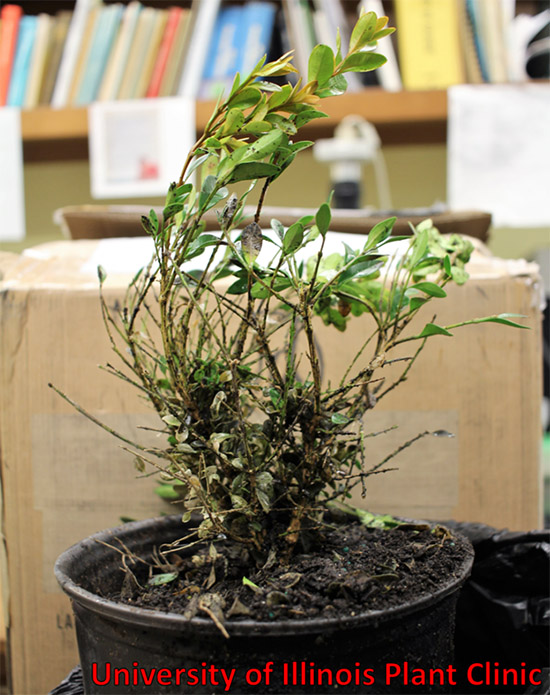Issue 1, April 24, 2017
Boxwood Blight
Boxwood blight has been confirmed in three locations in Illinois as of April 2017. This is a serious fungal disease, and the pathogen is regulated by the Illinois Department of Agriculture.
In late 2016, two boxwood samples were submitted to the University of Illinois Plant Clinic. Both samples came from northeastern Illinois (Lake and Cook counties) and both were from recent landscape additions (one location was planted in 2016, the other was planted in 2015). While the characteristic leaf spots were not apparent on the samples, defoliation and stem cankers were noted. The samples were quarantined and, after sufficient incubation, fungal spores consistent with Calonectria spp. were recovered. The species was confirmed as C. pseudonaviculata by the United States Department of Agriculture Animal Plant Health Inspection Service Laboratory in Maryland. A third location was confirmed in Clinton County at a production nursery. To our knowledge, all the infected plants originated from out of state.
Boxwood blight is a potentially devastating disease affecting members of the Buxaceae family. The disease has been found on boxwood, pachysandra, and sarcococca. The disease is caused by the fungi Calonectria pseudonaviculata (syn. Cylindrocladium pseudonaviculatum and C. buxicola) and Calonectria henricotiae. To date, C. henricotiae has not been found in the United States.
Boxwood blight was formerly federally regulated, but is now regulated at the state level. Because it is a regulated pathogen, suspect samples must be sent to a USDA-APHIS facility. While it can cause widespread death of hosts in the environment, the spores of the pathogen do not appear to travel extensively reducing its overall impact. However, in production facilities where equipment can be contaminated and expose hundreds or thousands of plants, the pathogen is a much larger concern. The pathogen can also overwinter in soil for several seasons.
Symptoms of boxwood blight include leaf spots, stem cankers, and defoliation. Leaf spots usually appear as light or dark brown circular lesions, often surrounded by a large yellow halo. If the infection occurs near the margin of the leaf, the lesion may be semi-circular or V-shaped. Stem cankers are easiest to see on new, green stem tissue. The cankers are dark brown or black, and are often linear or diamond-shaped. Defoliation occurs as the final symptom. Because these symptoms can be similar to other common fungal and environmental problems on boxwood, we strongly suggest submitting samples to the University of Illinois Plant Clinic for confirmation.

Photo 1. Leaf spots and
lesions on a plant infected with boxwood blight.

Photo 2. Dark stem
lesions on a boxwood plant infected with boxwood blight.

Photo 3. Severe
defoliation of a boxwood plant infected with boxwood blight. Note that the defoliation is progressing from the bottom of the plant
upwards.
We recommend scouting boxwood and pachysandra plants, especially those that were installed in the last few years or plants that are near host plants that were planted recently. Because it is a regulated pathogen, suspect samples must be sent to a federally-designated plant diagnostic laboratory; the University of Illinois Plant Clinic is this laboratory in Illinois.
For more information about this disease, including additional photographs of symptoms and information about submitting a sample, please see the Plant Clinic's fact sheet: https://uofi.box.com/v/boxwoodblight
The pathogen was identified for the first time in the United States in 2011, and has since been found in 18 states. Most are located in the eastern part of the country, though confirmations have been made in Missouri and Ohio. (Diane Plewa)
Author:
Diane Plewa